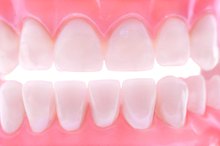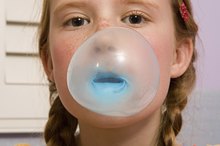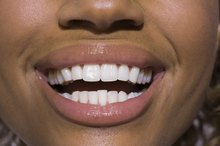Recipe for Homemade Denture Adhesive
Dentures are sets of artificial teeth designed to fit inside the mouth. They are worn by people who no longer have their natural teeth.
When natural teeth are removed, the jawbone begins to deteriorate.
Over time, this affects the shape of the gums, which can cause dentures to shift uncomfortably inside the mouth. To hold dentures in place, an adhesive can be placed along the inside of the prosthetic before insertion. This will hold the denture steady throughout the day, allowing the wearer to function with a higher degree of confidence and comfort.
Adhesive
To make a standard adhesive at home, collect the following items: karaya gum power from your local health food store, tragacanth gum powder from the cake decorating supplies at your local craft store, and peppermint oil. Measure 1 oz. of karaya gum powder into a small bowl 1. Add 3 oz. of tragacanth powder. Stir until the two are well blended and then transfer to a small bottle. Add 30 drops of peppermint oil.
Place the cap on the bottle and shake vigorously for one minute or until the oil and powders are thoroughly mixed.
Sprinkle ¼ teaspoon of the gum blend across the surface of the denture and insert into the mouth. Hold firmly in place for 30 seconds and release. The gums should bond lightly with the exposed tissues of the mouth, holding the dentures in place for up to 12 hours.
- To make a standard adhesive at home, collect the following items: karaya gum power from your local health food store, tragacanth gum powder from the cake decorating supplies at your local craft store, and peppermint oil.
- Place the cap on the bottle and shake vigorously for one minute or until the oil and powders are thoroughly mixed.
Gum
How to Remove Gum From Dentures
Learn More
For a less traditional take on the gum adhesive, try making a denture bonding agent from standard-issue bubble gum. The ingredients are easier to find and the flavor can be a bit more pleasant. Begin by placing 1/3 cup of unwrapped gum pieces into a microwave-safe bowl. Microwave the gum for one minute on full power. Mix well with a wooden dowel rod or wooden stick, until the gum is thoroughly blended. Measure ¼ cup of confectioner sugar onto a sheet of waxed paper. Push the sugar into a pile and use your fingers to create a small well in the center. Transfer the melted gum to the well in the sugar.
**Use your fingers to move the sugar from the sides to the top, covering the gum completely.
** Then roll and press the gum, manipulating it until all of the sugar has been incorporated. The gum mixture will be stiff, but not overly sticky. Pull off a piece of gum about the size of a standard marble.
Wipe the inside surface of the denture with a moist cloth and then stretch the gum to fit across it, pressing the edges of the gum into the curvature of the mouthpiece. Insert the denture and bite down, pressing it into place. **This should hold your dentures in position for up to four hours.
Any leftover gum should be wrapped in plastic cling film. ** It can be safely stored at room temperature for up to four weeks.
- For a less traditional take on the gum adhesive, try making a denture bonding agent from standard-issue bubble gum.
- Use your fingers to move the sugar from the sides to the top, covering the gum completely.
Peanut Butter
Notorious for sticking to the roof of your mouth, peanut butter can be a quick fix for dentures. Spread 1 tbsp. of creamy peanut butter across the surface of your dentures and insert them into your mouth. Bite down and hold for 30 seconds to press the apparatus into place and then go on about your business. Peanut butter can effectively hold your dentures in position for two to three hours, buying you enough time to get to the store to purchase the proper adhesive.
- Notorious for sticking to the roof of your mouth, peanut butter can be a quick fix for dentures.
- Peanut butter can effectively hold your dentures in position for two to three hours, buying you enough time to get to the store to purchase the proper adhesive.
Related Articles
References
- Grandad's Wonderful Book of Chemistry; Kurt Saxon; 1987
Writer Bio
Lisa Parris is a writer and former features editor of "The Caldwell County News." Her work has also appeared in the "Journal of Comparative Parasitology," "The Monterey County Herald" and "The Richmond Daily News." In 2012, Parris was honored with awards from the Missouri Press Association for best feature story, best feature series and best humor series.








